Temperament and behaviour - general information
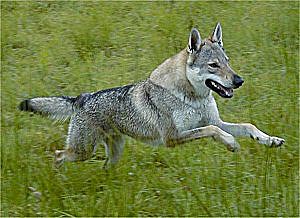 This
is a relatively new breed of dog, which can boast neither hundreds of years
of tradition nor the names of famous rulers or eminent personalities who bred
it or owned it. Nevertheless, it attracts attention wherever it appears. Nobody
doubts, not for a moment, that these dogs are of the most distinguished origin.
Their mother is Nature. It looks like a wolf. It is tall but light and strong.
Its straight thick hair is wolf-like grey with a typical white mask. It will
size you up confidently, with its light eyes, set obliquely. It does not look
at its owner; it knows exactly, at every moment, where its master is and what
he is doing. It pays attention rather to its surroundings - it wants to have
a good view. It can run a 100 kilometers easily, has a great sense of direction,
and reacts with lightening speed. No trail is too difficult for it to follow.
No matter whether it is raining or freezing or whether it is day or night. There's
nothing it could not manage if it wants to. Every year coming the new puppies
from two mother's countries - Czech Republic and Slovak Republic. The first
breedings were recorded in Austria, Slovenia, and Hungary; animals were imported
to a number of countries. The dogs are shown every year at the leading dog shows
and exhibitions.
This
is a relatively new breed of dog, which can boast neither hundreds of years
of tradition nor the names of famous rulers or eminent personalities who bred
it or owned it. Nevertheless, it attracts attention wherever it appears. Nobody
doubts, not for a moment, that these dogs are of the most distinguished origin.
Their mother is Nature. It looks like a wolf. It is tall but light and strong.
Its straight thick hair is wolf-like grey with a typical white mask. It will
size you up confidently, with its light eyes, set obliquely. It does not look
at its owner; it knows exactly, at every moment, where its master is and what
he is doing. It pays attention rather to its surroundings - it wants to have
a good view. It can run a 100 kilometers easily, has a great sense of direction,
and reacts with lightening speed. No trail is too difficult for it to follow.
No matter whether it is raining or freezing or whether it is day or night. There's
nothing it could not manage if it wants to. Every year coming the new puppies
from two mother's countries - Czech Republic and Slovak Republic. The first
breedings were recorded in Austria, Slovenia, and Hungary; animals were imported
to a number of countries. The dogs are shown every year at the leading dog shows
and exhibitions.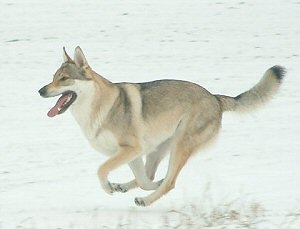 After
Czechoslovakia split up on January 1, 1993, the legal systems of the two newly
established states started to differentiate rapidly. The existence of a united
Club of Breeders became untenable. The Club of Breeders of the Czechoslovakian
Wolfdog was split up with the decision of its conference in Bratislava, January
23, 1993, into two independent groups which control the breeding of the breed
in their own countries. After the change, the Club of Breeders of the Czechoslovakian
Wolfdog, with its seat in Prague operates in the Czech Republic. It is a member
of CMKU - F.C.I.. F.C.I. recognized the standard of the breed on June 13, 1989
(Helsinki) under the No. 332. The proposal was presented by representatives
of (nowadays nonexistent) Czechoslovakia, which remains not only the name of
the breed, but also the country of its origin. The Czechoslovakian Wolfdog is
a working breed; it belongs to F.C.I. group 1.
After
Czechoslovakia split up on January 1, 1993, the legal systems of the two newly
established states started to differentiate rapidly. The existence of a united
Club of Breeders became untenable. The Club of Breeders of the Czechoslovakian
Wolfdog was split up with the decision of its conference in Bratislava, January
23, 1993, into two independent groups which control the breeding of the breed
in their own countries. After the change, the Club of Breeders of the Czechoslovakian
Wolfdog, with its seat in Prague operates in the Czech Republic. It is a member
of CMKU - F.C.I.. F.C.I. recognized the standard of the breed on June 13, 1989
(Helsinki) under the No. 332. The proposal was presented by representatives
of (nowadays nonexistent) Czechoslovakia, which remains not only the name of
the breed, but also the country of its origin. The Czechoslovakian Wolfdog is
a working breed; it belongs to F.C.I. group 1.
Appearance
Both the build and the hair of the Czechoslovakian Wolfdog are reminiscent of
a wolf. The lowest dewlap height is 65 cm for a dog and 60 for a bitch and there
is no upper limit. The body frame is rectangular, ratio of the height to length
is 9:10 or less. The expression of the head must indicate the sex. Amber eyes
set obliquely and short upright ears of a triangle shape are its characteristic
features. The set of teeth is complete (42); very strong; both scissors-shaped
and plier-shaped setting of the dentition is acceptable. The spine is straight,
strong in movement, with a short loin. The chest is large, rather flat than
barrel-shaped. The belly is strong and drawn in. The back is short, slightly
sloped, the tail is high set; when freely lowered it reaches the tarsuses. The
fore limbs are straight, and narrow set, with the paws slightly turned out,
with a long radius and metacarpus. The hind limbs are muscular with a long calf
and instep.
The color of the hair is from yellow-grey to silver-grey, with a light mask. The hair is straight, close and very thick. Czechoslovakian Wolfdog is a typical tenacious canterer; its movement is light and harmonious, its steps are long.
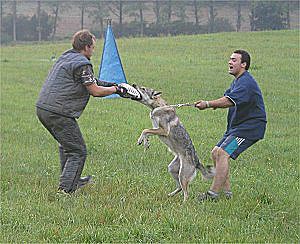 Character
and behavior
Character
and behavior
During the development of the breed the tenacity of the dogs was tested. The
Czechoslovakian Wolfdogs can run a hundred-kilometer distance easily at an average
speed of over 12 km/h. When seeing the wolf-like appearance of the Czechoslovakian
Wolfdog, one can ask: And what about its character? How does the wolf origin,
so evident on the exterior of the dog, influence its behavior? Is the breeding
of such dogs difficult for the owner? Let's try to characterize these dogs in
a few paragraphs. Czechoslovakian Wolfdogs develop very strong social relation
not only with their owner, but with the whole family. Moreover, they represent
the "privileged position" of children and let them as well as puppies do such
things they would not permit from adults and dogs. They can easily learn to
live besides other domestic animals which belong to the family; however, if
they meet strange animals, difficulties can occur. It is vital to sub due their
passion for hunting when they are puppies. The puppy should never be isolated
in the kennel; it must get used to different surroundings, to traveling and
so on. Bitches are easily controllable; dogs often experience a stormy growing-up.
The Czechoslovakian Wolfdog is very playful and temperamental; it learns easily. We can admire its all-around qualities rather than its specialization. However, we should not expect it should train spontaneously, the behavior of the CsV is strictly purposeful - it is necessary to find motivation for training. The most frequent cause of failure is usually the fact that the dog is tired out with long useless repetitions of the same exercise, which results in the loss of motivation. These dogs have admirable senses and are very good at following trails. They are really independent and can cooperate in the pack with a special purposefulness. If required, they can easily shift their activity to the night hours. The independent work of the pack without the necessary control of a man was the reason for their use in the army. Sometimes problems can occur during their training when barking is required. Czechoslovakian Wolfdogs have a much wider range of means of expressing themselves and in some situations barking is unnatural for them; they try to communicate with their masters in other ways. Generally, to teach CsV stable and reliable performance takes a bit more time than does to teach traditional specialized breeds.
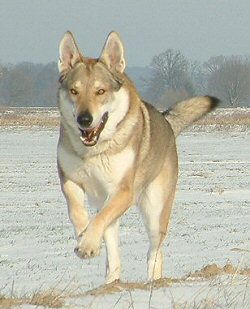
Is the Czechoslovakian Wolfdog the breed for
me?
Every owner of any breed or type of dog should be responsible, aware, and caring.
The need for proper housing, medical care, food, training and socialization
are just some of the basic requirements that should be understood before any
person undertakes to own any dog. Unless a potential dog owner is willing and
able to give these essentials, dog ownership should be delayed or even avoided
altogether. To own a pet and not to provide for it´s needs is certainly cruel,
neglectful, and even illegal. Because of controversy that surrounds dogs of
the Wolfdog kind, potential owners of these dogs must be even more aware of
there responsibilities than owners of many other breeds. There are some key
points to consider about owning an CzW:
- These dogs tend to be smart, alert dogs that need early, consistent training.
- These dogs have been exploited for generations by people whose idea of dog ownership differs radically from most pet owners.
- These dogs cannot be tied to a tree or simply be left in a kennel or the backyard. They are true lovers of people and will suffer if deprived of lots of human contact.
- If you are looking for a guard dog I would suggest
that u get another breed , these dogs tend to love all people to much , but
could be trained to be guard dogs if u are willing to give it the time.
Are you right for the Czechoslowakian Wolfdog?
Before buying a dog answer this honestly:
- Have you owned other kind of dogs that will give you some reference point and some experience for owning an CzW?
- Are you willing to invest time and money to search and get the right pet for you and your family?
- Do you have the resources and the inclination to help a young puppy get the socialization, care and training it will need to grow into the best possible pet?
- Do you have the time and space to share with a dog that will need a lot of affection, direction and attention?
- Are you willing to walk the extra dog mile that this breed will need?

This is probably purely a matter of personal preference. A female of any breed
is generally a little less challenging for pet owners. Male dogs of most breeds
tend to be more aggressive, not that females can´t be. Unneutered males will
arduously pursue females in heat and that might be quite tough and test your
nerves. A male will mark his area with urine when walking him, and some people
will see that as a "problem". The best thing to do is to talk to several owners
and get there point of view, tell them your current situation and discuss your
needs with the breeder too.
A puppy or an older dog?
The puppy will give you ample opportunity to mold it and shape it into the best
pet it´s genetic makeup will allow it to be. Unlike an adult, this youngster
will not have a lengthy past history (positive or negative) to forget. You can
concentrate on initial training and socialization rather then on retraining
and re-socialation. When a puppy is brought to a well-prepared home in addition
for the puppy, the youngster can easily become an integral part of everyday
activity.
What should I pay for a dog?
Prices vary depending on the dogs background and lines , game breed or not ,
kennel or house breed dog. In general the prices vary (mostly between $500-$700)...So
I don't think you will need to pay more than that. Always see to that u get
a paper with your dogs background (pedigree), and a vaccination card so u know
that your pup is cared for in his first couple of weeks of life.
Preparing your home...
There are a lot of things that you will need to think of before you bring the
puppy to its new home. This little creature u soon are to bring to your home
needs to be taken care of in the best possible way...
- First you need to get all the things that may harm the pup away from it. Get down on your knees and take a look from the pups point of view.
- I mean electrical cords that the pup may chew on, and other sharp things that may hurt the pup like neadles and stuff that it may get stuck in its throat.
- The other aspect of this is to keep the dog from eating things you might want to keep him/her away from eating, like your shoes and things like that.
- Keep poison (ex: rat poison) and other chemicals stored away from the puppy at a safe place.
- Reposition of any heavy items that could be pulled over onto a pup.
- Block off balconies , stairwells and porches where a puppy could fall and be injured or killed.
- Keep good fencing so it wont run out on the street and get hurt by cars or other pets.
TOYS: you will find a lot of good toys for your pup in animal shops so the pup can bite something that aint expensive to repair, its teeth will grow and itch during his first months, so it is natural for him/her to bite things to ease the itch/pain when they grow. Just remember that the CzW have powerful jaws, and all dog toys is not as good for them as they may be for other breeds - buy strong toys.
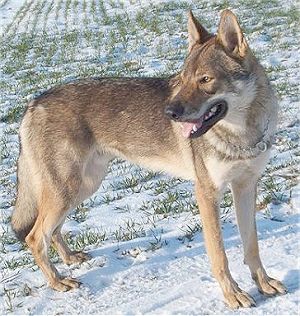 Pack
behavior
Pack
behavior
The pack is the most important part of a dog´s life. It is the natural castle
system or "pecking order" that dictates where each and every dog fits in. Wild
dogs will form identical pack hierarchies just like wolves. The pack has a clearly
defined rank ordering system with each animal at it´s own level, dominant over
those below it on the ladder, subservient to those above it. The leader, identified
as the "alpha" or first male, is usually the biggest, strongest, most keenly
intelligent dog in the pack. All other pack members bend to the will of this
leader unless they are ready to challenge him for the top spot. Pack behavior
is something your pup already has understood when it get´s to your hom. It learned
it from it´s mother. The mother is always in the leader of her litter pack,
but the siblings work out who is the next in line and so forth. Understanding
pack behavior is crutial to training your pet. Like using denning behavior in
cratetraining, pack behavior can be used to make certain that your CzW knows
it´s place within the family and is content with the arrangement. To avoid problems
that can occurre with any dog of any breed, you will need to be the dominant
leader. You will have to fill the "ALPHA SLOT". The other members of your family
or house hold will be the other pack members with the dog fitting in neatly
as the last one on the list. The pack is not some kind of power game everyone
plays against the dog. Pack membership for a canine is as natural as any other
instinctive behavior. It serves as an important ballast in the dog´s life providing
the secure , appropriate rank placement , and sense of belonging that dogs need.
A well-adjusted , well-socialized CzW needs to understand where it fits in within
it´s social universe. You, or some other responsible human, will have to assume
responsibility for seeing that this natural chain of command is instilled in
your family and kept in place. You can observe iin any group of
dogs. Two dogs meet for the first time. They stand rather stifflegged, often
going through the sniffing ritual. Unless a fight is imminent, one dog will
recognize that it is subservient to the other. The subservient dog will assume
submersive demeanor and submissive things to show that it is to no threat to
the dominant animal. Some of these sumersive behaviors are cringing, offering
no defense, rolling over to it´s back, or even releasing small amounts of urine.
Socialization, training, and recreational activities
CzWs are generally inclined to be friendly. This is usually true even with dogs
that have not been properly socialized around people. Still, you will want to
take no chances. From the time your puppy is tiny, you should encourage friends,
strangers, and neighborhood kids of all ages to pick her up and play with her.
Try to make your puppy's associations with humans overwhelmingly positive. Walk
your puppy through crowded public places, such as street fairs, to get her accustomed
to the presence of lots of people. With this breed, human-aggressiveness is
rare. However, as in all breeds, there will occasionally be a human-aggressive
individual--usually, but not always, the result of backyard breeding or neglect
and abuse. Owning such a dog is, to say the least, a tremendous liability.
There are various degrees and causes of human-aggressiveness in dogs. Sometimes the problem is classic dominance-aggression, and it can be nipped in the bud at an early age if you appropriately reestablish your dominance. In any case, at the first sign of a problem, you should immediately seek expert help from a behaviorist or trainer with experience specifically with this breed. The socialization process cannot begin too early. Find other responsible owners of small puppies and non-aggressive adult dogs (all inoculated, of course) and make sure to have regular (daily, if possible) periods where the dogs can get together and play. Like human beings, dogs are social creatures. They are happiest in the company of their own kind. Yet playing with other dogs is not something that a dog is born knowing how to do; it is learned through experience: by imitation a puppy learns the difference between appropriate and inappropriate behaviors. You should closely supervise your puppy in these dog play groups.

Like socialization, basic obedience training should also begin early. With this breed, it is essential to have your dog completely under voice control. Contrary to a common misunderstanding, training will NOT "break the spirit" of an CzW. Dogs are hierarchical pack animals. Their psychological well-being depends on their knowing with certainty their exact status in the pack and on their having a definite lead to follow. This "pack mentality" is the instinct that made canines domesticable: a dog regards her human family as her pack and looks to her masters as the pack leaders. A dog that is never trained and is allowed to do anything it pleases will be perpetually anxious and confused, since this absolute freedom and the resulting uncertainty as to who is really the pack leader produces insecurity in a canine. It is mainly for this reason, and not for hunger alone, that lone wolves and lost dogs are especially unhappy; their freedom is too much for them to handle.
Once your dog is properly socialized and trained, there is no limit to the activities that you can enjoy with your dog. Having been bred for prolonged, high-intensity activity, they can run for hours and hours, and so they make great hiking or mountain-biking companions. CzWs not only enjoy lots of hard exercise, they NEED it.
An exhausted CzW is a happy CzW.
If you won't have the time to exercise your dog regularly, you should choose another breed. You don't need a big back yard to provide you dog with sufficient exercise. You can work your dog up to 30-45 minutes daily. Be careful not to push your puppy to overexertion while her bones are still growing. Puppies should be allowed to establish their own comfortable level of exercise. Serious use of a treadmill should only begin at a year and a half or older.
Health
On the whole, the CzW are a very healthy, robust breed. As far as life span
in concerned, 12-15 years is probably about average, although a 17 year old
CzW is not unheard of.

Comments